The magnificent frescoes of Yaroslavl: The Church of John the Baptist at Tolchkovo
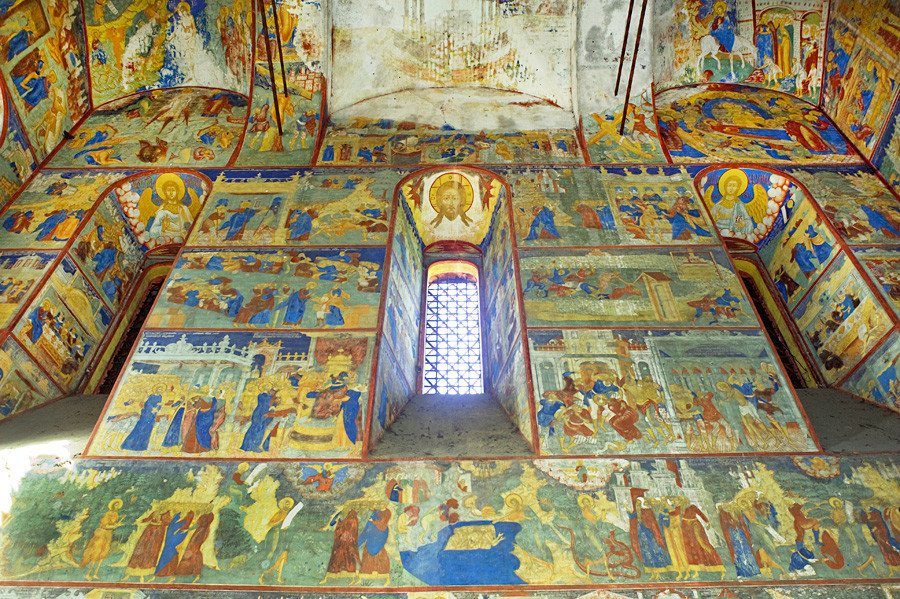
Yaroslavl. Church of Decapitation of John the Baptist at Tolchkovo. Interior, north wall. Bottom row: scenes from life of John the Baptist. Second row: scenes from Passion of Christ. Upper rows: scenes from life and parables of Christ. Aug. 15, 2017.
William BrumfieldThe city of Yaroslavl, located on the Volga River 150 miles northeast of Moscow, has one of Russia’s greatest concentrations of church architecture and art, including a number of magnificent 17th-century frescoes. During his travel along the Volga in the summers of 1910 and 1911, the photographer Sergei Prokudin-Gorsky worked extensively in the churches of Yaroslavl. My photographic documentation of Yaroslavl’s churches extends three decades, from 1987 to 2017.
One Yaroslavl monument, the Church of the Decapitation of John the Baptist at Tolchkovo, fascinated not only Prokudin-Gorsky
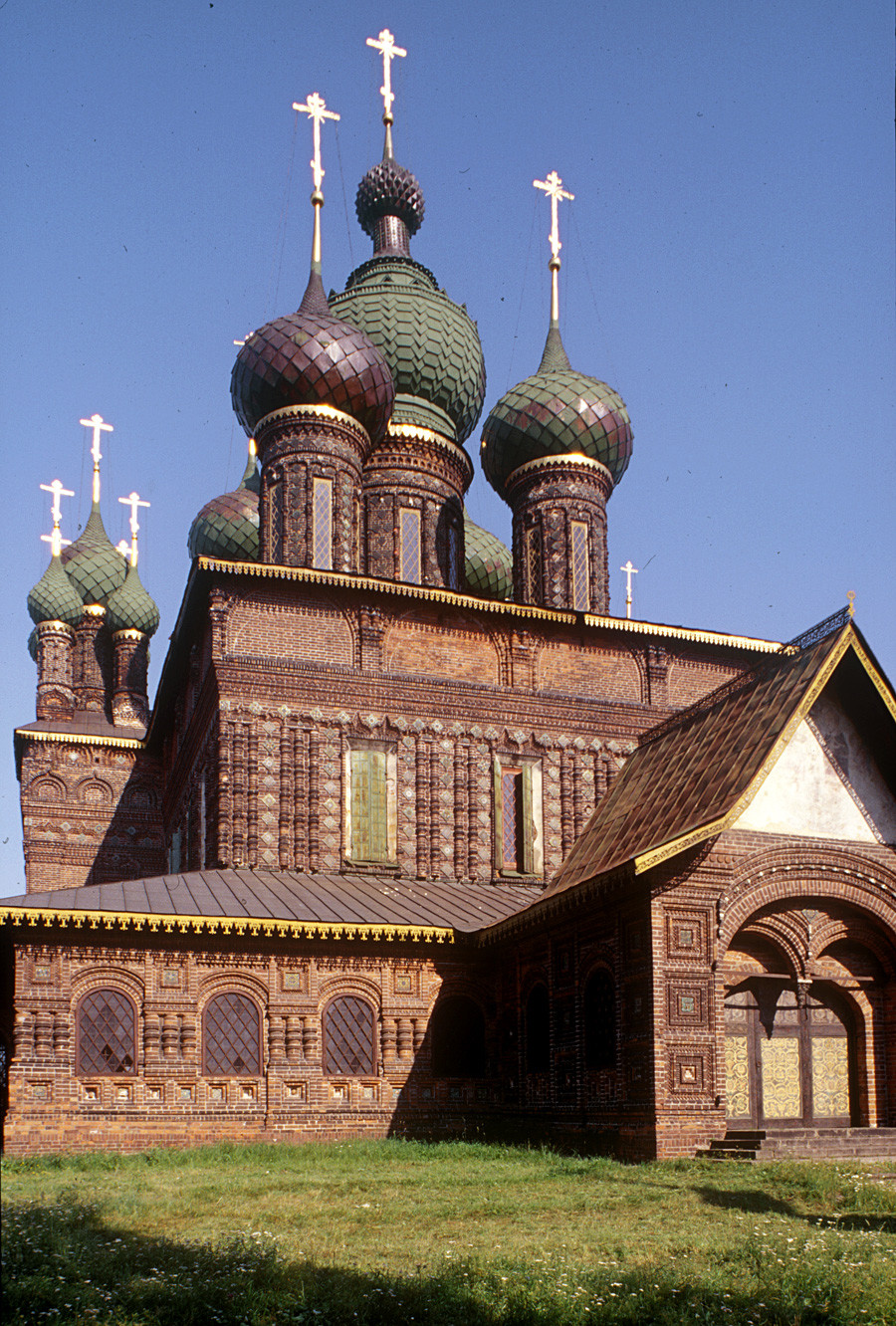
Church of Decapitation of John the Baptist at Tolchkovo. Northwest view. Far left: north gallery. July 24, 1997.
William BrumfieldAs seen below, the Vereshchagin paintings not only summon the mysterious aura of the frescoes, but they also convey the relation of the art to people — pilgrims, peasants
Constructing the John the Baptist Church
In 1671, Jonah Sysoevich, the powerful Metropolitan of Rostov, approved a proposal for the construction of a new church in the prosperous Tolchokovo district near that Kotorosl River, a small tributary of the Volga. The Church of the Decapitation of John the Baptist was created between 1671 and 1687 with support from local parishioners and donors from Kazan. Leading benefactors included the Yeremin family, whose wealth derived from leather workshops located in the district.
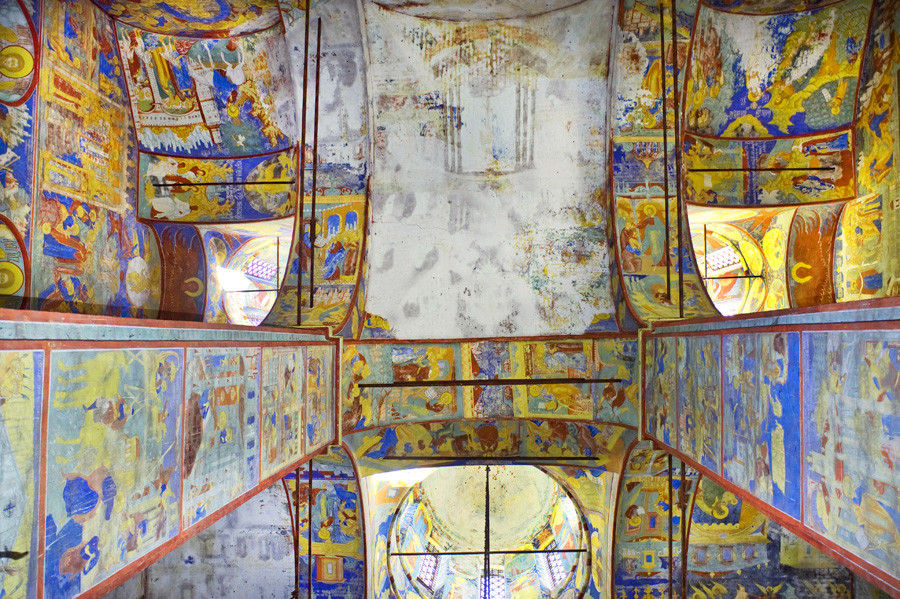
Church of Decapitation of John the Baptist. West piers & west ceiling bays. Upper left: fresco of Entry of Christ into Jerusalem. Aug. 15, 2017.
William BrumfieldThe plan of the Tolchkovo church included an enclosed gallery attached
The monumental exterior of the Church of John the Baptist leads to an equally remarkable interior covered with frescoes. It is something of a miracle that the Tolchkovo ensemble and the frescoes have, for the most part, survived. During the 1930s, a large chemical plant that produced paints expanded on the adjacent territory, and the church was used for storage, including harsh chemicals. Fortunately, the Yaroslavl Museum eventually regained control of the space.
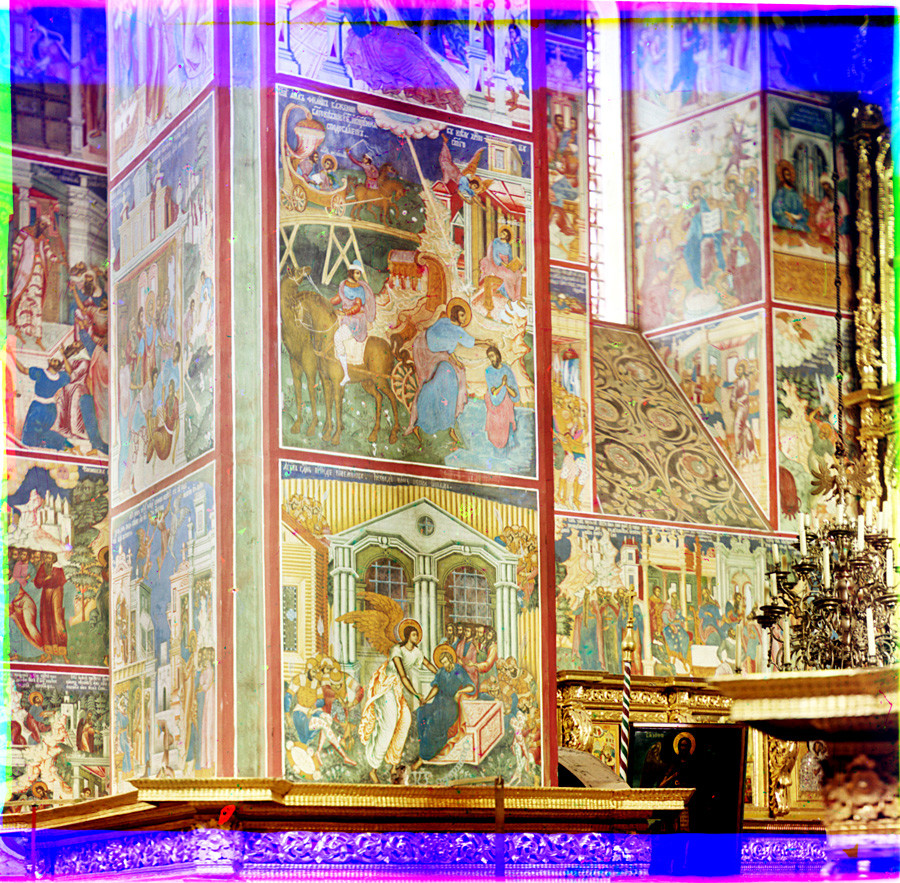
Church of Decapitation of John the Baptist at Tolchkovo. Northwest pier with frescoes: St. Peter freed from prison (bottom) & St. Philip baptizes the Ethiopian Eunuch. Background: north wall & icon screen. Summer, 1911.
Sergei Prokudin-GorskyGalleries of frescoes
There is at least basic information about the masters whose work covers the walls of this large interior, from the galleries and side chapels to the altar. The main space was painted from June 1694 to July 1695 by a group of 16 artists under the guidance of Yaroslavl masters Dmitrii Grigorev Plekhanov and Fedor Ignatiev, who also did frescoes for the side chapels in 1700.
Plekhanov was already renowned for his work at the Archangel Cathedral in the Moscow Kremlin, and at other major churches in Rostov, Yaroslavl
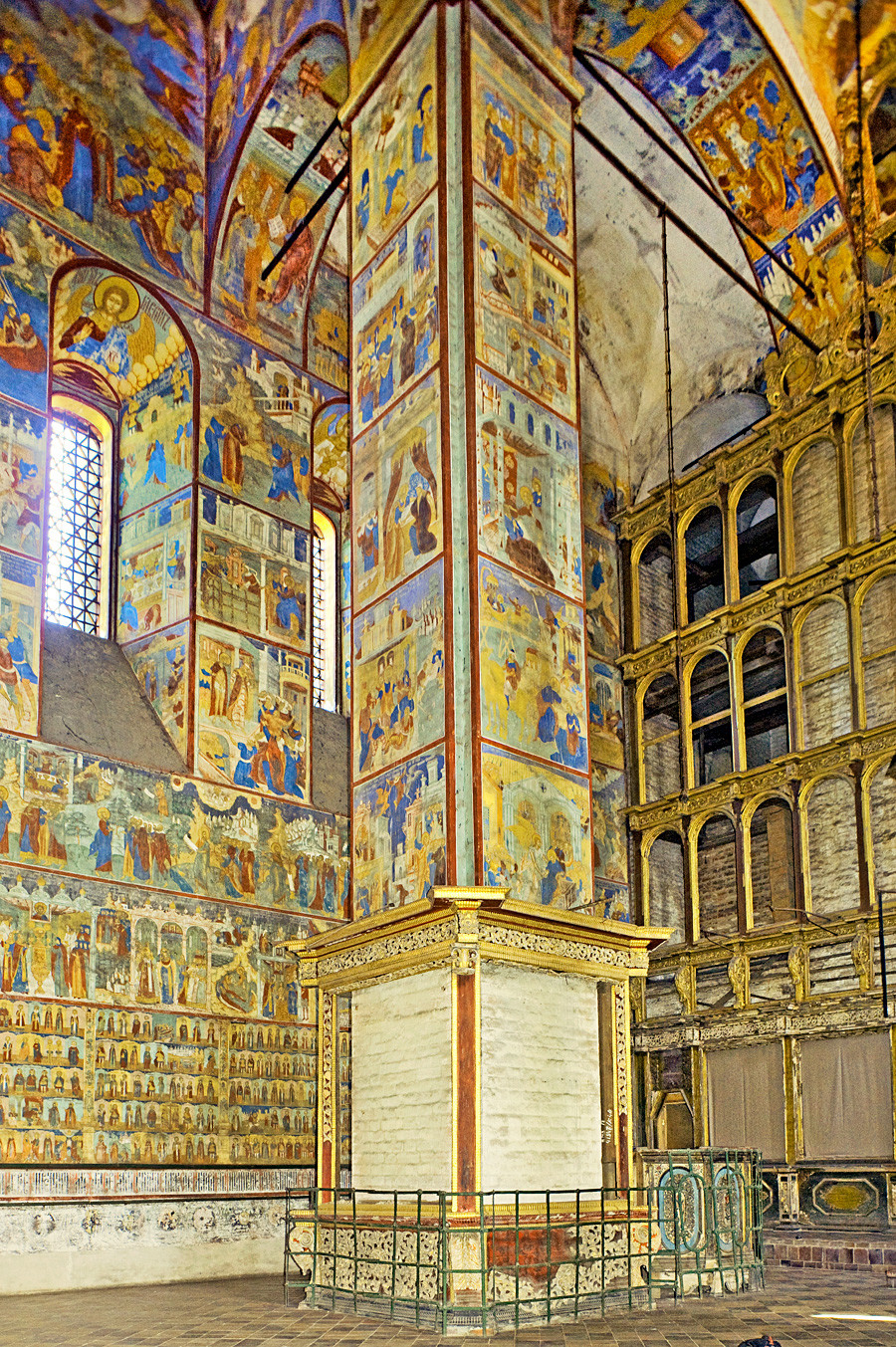
Church of Decapitation of John the Baptist. Northwest pier. Background: north wall & icon screen. Aug. 15, 2017.
William BrumfieldThe north and south walls are divided horizontally into nine registers. The three registers at the top illustrate the life and teachings of Christ. The fourth level from the top displays the Passion of Christ. Closer to the viewer’s eye level, the fifth and sixth registers from the top illustrate the life of John the Baptist, with emphasis on the Beheading and the Finding of the Head of John the Baptist. (In addition to the Beheading, the Orthodox Church observes three holidays dedicated to the Finding of the Head of John the Baptist.)
The seventh register from the top displays an unusual rendering of scores of Orthodox saints arranged by the days of the calendar. The bottom two levels of the north and south walls consist of an inscription band about the church and a decorative border. At the very top, the ceiling vaults show major festivals such as the Dormition. As usual, the central dome contains a portrayal of Christ Pantocrator (ruler of the world).
Of the four massive piers that support the ceiling vaults, only the two west piers are visible in the main space. The east piers are concealed behind an elaborately carved six-tiered icon screen originally made over a period from 1687 to 1701. After the closing of the parish in the early 1930s, the icons were removed for conservation.
Prokudin-Gorsky photographed vivid details on the lower part of the south face of the northwest pier. The two scenes depict the Apostle Peter escaping from prison and the Baptism of the Ethiopian Eunuch by the Apostle Philip. My view with a wide lens gives a sense of the space around the pier, including the north wall and the frame of the icon screen.
However impressive the main space, the frescoes that cover the enclosed galleries (
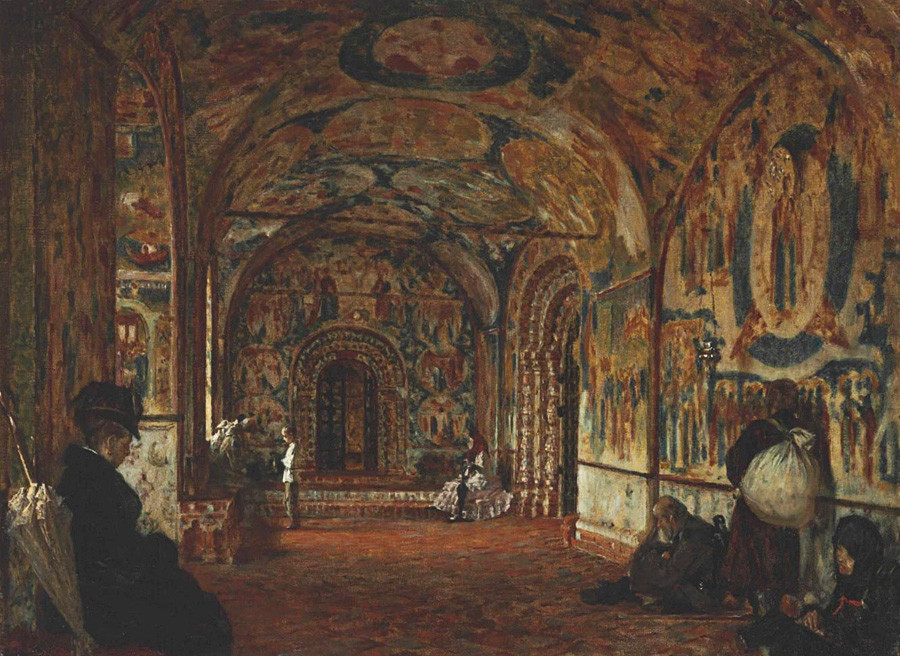
Vasily Vereshchagin. Gallery (papert) of Church of John the Baptist at Tolchkovo. Painted in 1888 in the north gallery of the church.
State Tretyakov GalleryThe curved ceiling vaults of the gallery display episodes from the Old Testament, such as the Fall of Jericho and the Six Days of Creation. The walls include depictions of the Seven Sacraments, the Last Judgement, the Fruits of the Paschal Mystery as well as scenes from edifying literary works such as The Great Mirror (Speculum Maius), a 13th-century encyclopedic compendium whose fragments appeared in Russian during the 17th century. The didactic nature of these scenes — often accompanied by texts — can be related to the use of the gallery as a resting place for pilgrims who visited the church, as well as a space for parishioners and others who came to the church for Confession and to speak with the priests.
Art from art
The didactic aspect of this public gallery space was captured in evocative paintings by Vasily Vereschagin, including a view of the north gallery. Amid the humble folk depicted here, we see a woman of means, dressed in black with a bright parasol nearby. Does the black indicate mourning? It seems plausible that Vereshchagin was acquainted with this mysterious figure, self-possessed and socially distinct from those around her.
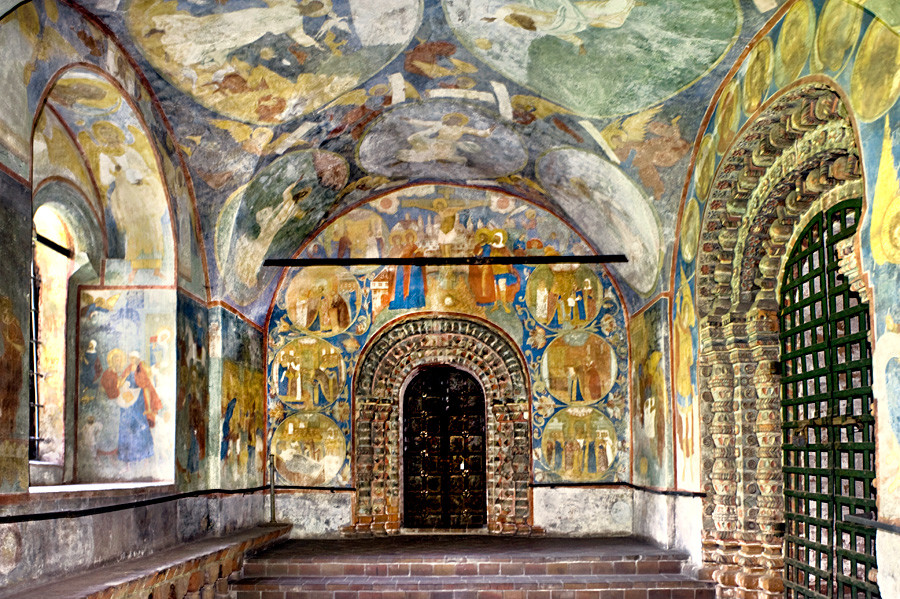
Church of Decapitation of John the Baptist. North gallery, view east. Above chapel portal: Crucifixion. Ceiling vaults: frescoes of Six Days of Creation. Right: north portal to main sanctuary. Aug. 15, 2017.
William BrumfieldIn 1992 and again in 2017, I photographed this space from a slightly different perspective. The photographs demonstrate Vereshchagin’s inspired fidelity to the frescoes, especially in his rendering of the Crucifixion above the portal to the northeast chapel.
After painting these and other scenes of the Yaroslavl area during the summer of 1888, Vereshchagin made a long-planned trip in the fall to the United States, where he exhibited his paintings to acclaim in New York and other cities. Early the next year he published an illustrated essay on traditional Russian culture (including the Tolchkovo church) in the February issue of Harper’s New Monthly Magazine.

Church of Decapitation of John the Baptist at Tolchkovo. West gallery with main portal. Summer, 1911.
Sergei Prokudin-GorskySome two decades after Vereshchagin’s visit, Prokudin-Gorsky photographed the gallery’s main (west) portal, which had recently been repainted. From my

Church of Decapitation of John the Baptist at Tolchkovo. West gallery, view north. Far right: left edge of main portal. Aug. 15, 2017.
William BrumfieldThe Tolchkovo frescoes — both in the gallery and in the main space — show the influence of engravings from 16th and 17th-century Bibles of German and Dutch origins. (During this period Yaroslavl had extensive mercantile connections with Dutch merchants.) Fanciful Western architectural details occur throughout the fresco backgrounds, while the figures themselves display colorful “Western” dress. This festive, imaginative presentation of religious scenes provides an encyclopedic sense of the prosperous cultural milieu of Yaroslavl in the late 17th century.
The value of the Tolchkovo frescoes was widely acknowledged in the 19th century when the church was visited by numerous august personages from the imperial court. Sustained efforts to conserve and restore the treasured frescoes began at the turn of the 20th century and continue to the present.
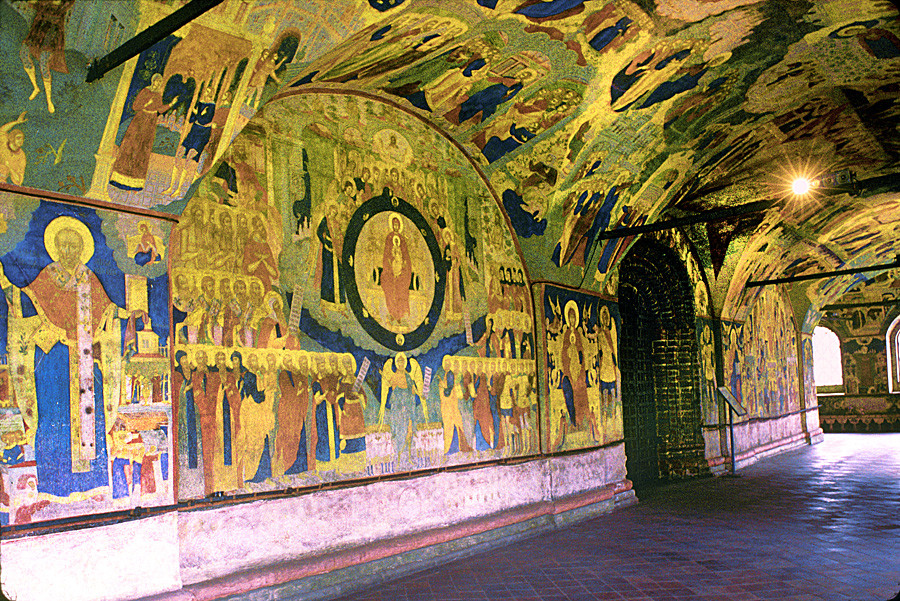
Church of Decapitation of John the Baptist at Tolchkovo. West gallery, view from northwest corner. Center: main portal. Left fresco: Hymn to the Virgin "In Thee Rejoiceth". Oct. 2, 1992.
William BrumfieldIn the early 20th century the Russian photographer Sergei Prokudin-Gorsky devised a complex process for color photography. Between 1903 and 1916 he traveled through the Russian Empire and took over 2,000 photographs with the process, which involved three exposures on a glass plate. In August 1918, he left Russia and ultimately resettled in France with a large part of his collection of glass negatives. After his death in Paris in 1944, his heirs sold the collection to the Library of Congress. In the early 21st century the Library digitized the Prokudin-Gorsky Collection and made it freely available to the global public. Many Russian websites now have versions of the collection. In 1986 the architectural historian and photographer William Brumfield organized the first exhibit of Prokudin-Gorsky photographs at the Library of Congress. Over a period of work in Russia beginning in 1970, Brumfield has photographed most of the sites visited by Prokudin-Gorsky. This series of articles will juxtapose Prokudin-Gorsky’s views of architectural monuments with photographs taken by Brumfield decades later.
If using any of Russia Beyond's content, partly or in full, always provide an active hyperlink to the original material.
Subscribe
to our newsletter!
Get the week's best stories straight to your inbox